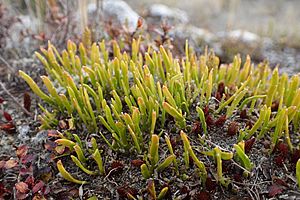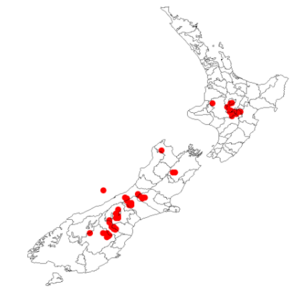Carmichaelia nana facts for kids
Quick facts for kids Carmichaelia nana |
|
|---|---|
 |
|
| Rangipo Desert, Waikato | |
| Conservation status | |
 Nationally Vulnerable (NZ TCS) |
|
| Scientific classification | |
| Kingdom: | |
| (unranked): | |
| (unranked): | |
| (unranked): | |
| Order: | |
| Family: | |
| Genus: | |
| Species: |
C. nana
|
| Binomial name | |
| Carmichaelia nana |
|
 |
|
| Where C. nana grows in New Zealand | |
| Synonyms | |
|
Carmichaelia enysii Kirk |
|
Carmichaelia nana is a special type of pea plant. It belongs to the Fabaceae family, which includes many plants like beans and lentils. This small plant is found in New Zealand, on both the North and South Islands.
In 2013, experts said C. nana was "At Risk (declining)". This means its numbers were going down. By 2018, its status changed to "Threatened-Nationally Vulnerable". This shows it needs more protection to survive.
What Does Carmichaelia nana Look Like?
C. nana is a very small, spreading shrub. It grows in a thick, flat mat close to the ground. It usually reaches only about 20 to 60 millimeters (less than 3 inches) tall. But it can spread out to be about 0.5 meters (nearly 20 inches) wide.
How Was Carmichaelia nana Named?
This plant was first described by a scientist named George Bentham. He called it C. australis var. β nana. Later, in 1864, another scientist, William Colenso, decided it was unique enough to be its own species. He gave it the name Carmichaelia nana in a book by Joseph Dalton Hooker.
The second part of its name, nana, comes from Latin. It means "tiny" or "dwarfed". This name perfectly describes how small this plant is!
Where Does Carmichaelia nana Live?
You can find Carmichaelia nana in many different places across New Zealand. It grows in lowlands, which are flat areas near the coast. It also lives in alpine habitats, which are high up in the mountains.
This plant likes to grow in riverbeds where floods have left behind sand and gravel. It also lives on terraces, which are flat areas above rivers. Sometimes, you can find it on moraines, which are piles of rocks and dirt left behind by glaciers.

